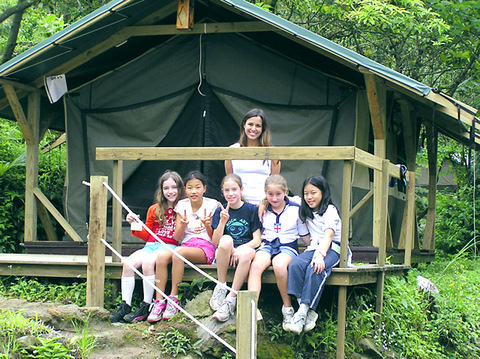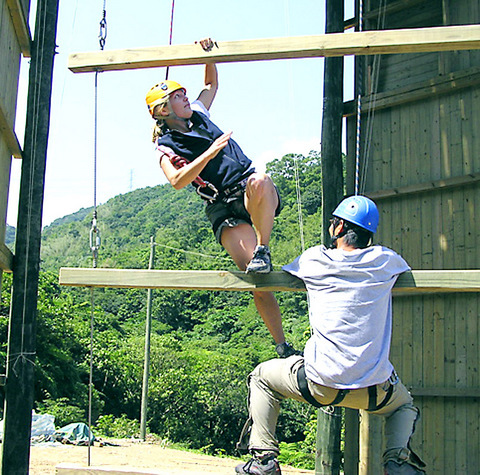On our way to the swimming hole we passed a group of campers holding butterfly nets and looking intently at a wildflower thicket.
"Catch any yet?" asked Camp Taiwan's co-director, American Tom McDonald.
"Lots! And two that are only found in Taiwan," replied his wife and the camp's other co-director, Canadian Nara McDonald.

Daily life at the newly opened North American-style summer camp is filled with adventure, learning and a deep appreciation for nature.
The McDonalds came upon the opportunity to realize their dream of building a summer camp through a friend and partner who owned a piece of land nestled in the foothills north of Yangmingshan in Wanli (
After a year of clearing and building, Camp Taiwan was completed. The camp consists of three clusters of safari-style tent cabins, a five-sided rope-course structure, a small stable with three horses and a large mess tent.

PHOTOS COURTESY OF CAMP TAIWAN
At present, the camp accommodates 60 campers and 15 staff, but the McDonalds plan to continue building in coming years and eventually accommodate 120 campers.
Nara McDonald, born into a diplomatic family, spent her childhood in various countries around the world. But every summer since the age of five she went back to Quebec for Camp Ouareau, a bilingual summer camp for girls, where she eventually worked as counselor and program director.
Tom, who grew up hiking, surfing and swimming in California and Hawaii, decided after 15 years of working in Taipei that he no longer wanted a job that required riding in an elevator.
The eight-rung rope ladder that hangs from the 10m-high climbing structure built by the US-based company Project Adventure is a far cry from an elevator. Watching two 13-year-olds using teamwork to reach the top is both suspenseful and inspiring.
Camp Taiwan embraces the concept of "challenge by choice," which means that each participant chooses the degree to which they participate in the challenges presented by the ropes-course activities.
"If one kid can get only two-thirds the way up the climbing wall, we celebrate that as much as another who gets all the way to the top," Tom McDonald said.
The ropes course gives campers a sense of accomplishment through accepting challenges but also teaches them how to respect and support each other.
Camp Taiwan is also dedicated to teaching campers an appreciation for nature and outdoor living. Educational activities teach the kids to identify plants and insects around camp and provide a basic understanding of ecology.
Though the mix of Chinese and Western food cooked by Tom and a local caterer is appreciated by all, campers must learn how to cook their own meals over the campfire. Fire-starting, hiking, horseback riding and archery are just a few of the activities that provide an appreciation for an older, simpler way of life.
"One of the most important things is what I like to call camp lore, which is the singing, the stories and the skits," said Tom, who feels that one of the central goals of summer camp is building a sense of community.
Earlier this week, the sense of community was glowing on the faces of campers and counselors.
"There's no boring part about it," said French counselor Benoit Zullo. "It's all fun."
"If I have the opportunity to come back next year, I will," said camper Charlotte, aged 14.
Starting July 18, Camp Taiwan's six-day, NT$12,500 sessions are open to all youngsters, ages 10 to 16, with a minimum of two years of instruction in English, the camp's language of operation. Beginning in late August, the camp will be open to all groups for camping, corporate retreats, etc.
For more information or to register, call (02) 2492 9200, visit www.camptaiwan.com or send an e-mail to tom@camptaiwan.com.

The canonical shot of an East Asian city is a night skyline studded with towering apartment and office buildings, bright with neon and plastic signage, a landscape of energy and modernity. Another classic image is the same city seen from above, in which identical apartment towers march across the city, spilling out over nearby geography, like stylized soldiers colonizing new territory in a board game. Densely populated dynamic conurbations of money, technological innovation and convenience, it is hard to see the cities of East Asia as what they truly are: necropolises. Why is this? The East Asian development model, with

June 16 to June 22 The following flyer appeared on the streets of Hsinchu on June 12, 1895: “Taipei has already fallen to the Japanese barbarians, who have brought great misery to our land and people. We heard that the Japanese occupiers will tax our gardens, our houses, our bodies, and even our chickens, dogs, cows and pigs. They wear their hair wild, carve their teeth, tattoo their foreheads, wear strange clothes and speak a strange language. How can we be ruled by such people?” Posted by civilian militia leader Wu Tang-hsing (吳湯興), it was a call to arms to retake

This is a deeply unsettling period in Taiwan. Uncertainties are everywhere while everyone waits for a small army of other shoes to drop on nearly every front. During challenging times, interesting political changes can happen, yet all three major political parties are beset with scandals, strife and self-inflicted wounds. As the ruling party, the Democratic Progressive Party (DPP) is held accountable for not only the challenges to the party, but also the nation. Taiwan is geopolitically and economically under threat. Domestically, the administration is under siege by the opposition-controlled legislature and growing discontent with what opponents characterize as arrogant, autocratic

When Lisa, 20, laces into her ultra-high heels for her shift at a strip club in Ukraine’s Kharkiv, she knows that aside from dancing, she will have to comfort traumatized soldiers. Since Russia’s 2022 invasion, exhausted troops are the main clientele of the Flash Dancers club in the center of the northeastern city, just 20 kilometers from Russian forces. For some customers, it provides an “escape” from the war, said Valerya Zavatska — a 25-year-old law graduate who runs the club with her mother, an ex-dancer. But many are not there just for the show. They “want to talk about what hurts,” she